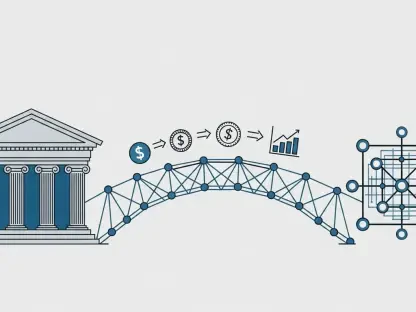Imagine a world where stock trading never sleeps, transactions settle instantly, and anyone, anywhere, can own a fraction of a major company like Nvidia or Tesla with just a few clicks. This is the promise of tokenized stocks, a groundbreaking fusion of blockchain technology and traditional equities that has captivated both the financial and cryptocurrency sectors with its potential to revolutionize investing. With the market value of these digital assets soaring to $412 million as reported by tokenization trackers, the allure of 24/7 trading and reduced costs is undeniable. Yet, beneath the excitement lies a complex web of risks and regulatory challenges that could shape the future of financial markets.
Introduction to Tokenized Stocks
Tokenized stocks represent a transformative innovation, leveraging blockchain technology to create digital instruments that mirror the performance of traditional equities. These tokens operate on a shared digital ledger, ensuring transparency and immutability while tracking the value of underlying assets such as shares in prominent corporations. By digitizing ownership, tokenized stocks aim to redefine how investments are accessed and managed, breaking down barriers inherent in conventional markets.
The rise of tokenized stocks has been fueled by a global surge in enthusiasm for digital assets, coupled with supportive policies favoring cryptocurrency integration. This momentum reflects a broader shift toward digitization in financial systems, where efficiency and accessibility are prioritized. As a result, tokenized stocks have emerged as a potential catalyst for modernizing stock trading, offering solutions to long-standing inefficiencies.
Their relevance extends beyond mere novelty, positioning tokenized stocks as a bridge between traditional finance and the burgeoning crypto economy. This intersection has sparked interest from both retail investors seeking new opportunities and industry giants aiming to capitalize on evolving trends. However, the path forward remains fraught with scrutiny, as regulators and stakeholders grapple with the implications of this innovation.
Key Features and Mechanisms of Tokenized Stocks
24/7 Trading and Instant Settlement
One of the most compelling aspects of tokenized stocks is their availability for trading at any hour, a stark contrast to the limited operating times of traditional stock exchanges. This round-the-clock access appeals strongly to retail investors, enabling participation across time zones without the constraints of market closures. Such flexibility has redefined expectations for how and when investments can be made.
Underpinning this feature is the blockchain technology that facilitates instant transaction settlement, eliminating the delays often experienced in conventional systems. This rapid processing not only enhances user experience but also boosts market efficiency by reducing the time capital remains tied up in pending trades. The operational benefits are clear, as transactions are completed in moments rather than days.
Performance metrics further validate these advantages, with tokenization trackers reporting significant increases in trading volumes for tokenized assets. Platforms leveraging this technology have seen heightened activity, reflecting growing investor confidence in the model. This data underscores the potential for tokenized stocks to reshape trading dynamics on a global scale.
Cost Reduction and Liquidity Enhancement
Another key benefit lies in the cost efficiencies achieved through tokenization, primarily by cutting out intermediaries that typically inflate transaction fees in traditional markets. Blockchain streamlines processes, automating tasks that once required manual intervention, thereby lowering expenses for investors. This democratization of cost structures opens the door to a wider audience.
Liquidity also sees a marked improvement, as tokenized stocks enable fractional ownership, allowing investors to purchase smaller portions of high-value equities. This capability attracts a diverse pool of participants, from small-scale retail traders to those previously excluded due to financial barriers. The result is a more fluid market where capital flows more freely.
Real-world examples highlight these advantages, with platforms like Robinhood and Kraken demonstrating tangible benefits in cost savings and enhanced liquidity. By integrating tokenized offerings, these entities have reported broader investor engagement and improved market depth. Such outcomes illustrate the practical impact of tokenization on financial accessibility.
Recent Developments in Tokenized Stocks
The tokenized stock market has witnessed explosive growth, with valuations climbing to $412 million as per recent data from industry trackers. Major players, including Coinbase, Gemini, and Nasdaq, have entered the fray, signaling robust confidence in the technology’s potential. Their involvement has accelerated innovation, pushing the boundaries of what tokenized assets can achieve.
Emerging trends point to a focus on creating tokenized securities that replicate the rights of traditional stocks, such as voting and dividends, amid a favorable political climate for crypto under current administrations. This shift reflects an industry-wide effort to align digital assets with established financial norms. Additionally, the race to launch products in regions like Europe and the U.S. continues despite diverse regulatory environments.
Industry behavior has adapted swiftly, with companies prioritizing rapid deployment to capture market share. This competitive landscape has spurred partnerships and technological advancements, even as regulatory bodies struggle to keep pace. The dynamic interplay between innovation and oversight remains a defining characteristic of this evolving sector.
Real-World Applications and Use Cases
Tokenized stocks are finding practical deployment across financial markets, with platforms like Robinhood expanding offerings in Europe to target retail investors. Startups such as Dinari have also emerged, focusing on making investment opportunities more inclusive through digital tokens. These initiatives highlight the technology’s role in broadening market participation.
Unique implementations further showcase the versatility of tokenized stocks, as seen with Robinhood’s promotional tokens tied to entities like OpenAI. These derivative structures, often backed by complex financial instruments like convertible notes, illustrate creative approaches to tokenization. Such strategies aim to attract attention while testing the boundaries of market acceptance.
Beyond marketing tactics, tokenized stocks address systemic inefficiencies in traditional trading by democratizing access to investments. They offer a pathway for individuals to engage with high-value assets without the prohibitive costs or structural limitations of conventional systems. This transformative potential continues to drive adoption across diverse demographics.
Challenges and Limitations of Tokenized Stocks
Despite their promise, tokenized stocks face significant hurdles, particularly the absence of investor protections. Many of these digital assets do not grant ownership, voting rights, or dividends, functioning instead as riskier derivatives. This discrepancy exposes investors to heightened counterparty risks tied to token issuers.
Regulatory ambiguity compounds these issues, with varying frameworks under European MiFID rules and U.S. securities laws creating uncertainty. Opposition from traditional finance powerhouses like Citadel Securities and SIFMA underscores concerns about inadequate safeguards. Their critique focuses on the potential for tokenized stocks to evade core protections inherent in conventional equities.
Market stability also remains a concern, as liquidity fragmentation could disrupt broader financial ecosystems by diverting trading activity from public exchanges. Systemic risks loom large if unchecked growth continues without oversight. Efforts by entities like Coinbase to align tokenized products with standard securities protocols represent steps toward mitigation, though challenges persist.
Future Outlook for Tokenized Stocks
Looking ahead, the trajectory of tokenized stocks hinges on striking a balance between pioneering innovation and establishing robust regulatory frameworks. The potential for standardized token structures could pave the way for greater trust and adoption. Such advancements would require collaboration across sectors to ensure consistency and security.
Possible breakthroughs, including integration with public markets as proposed by Nasdaq, offer a glimpse into a future where tokenized and traditional stocks coexist seamlessly. This convergence could redefine investment landscapes, providing seamless access while maintaining established protections. The vision of a unified market remains a compelling goal for stakeholders.
Long-term impacts on financial markets and society could be profound, with enhanced accessibility for retail investors and modernized trading systems at the forefront. If current challenges are addressed, tokenized stocks might catalyze a shift toward more inclusive and efficient financial ecosystems. The journey forward will depend on navigating the complex interplay of technology and regulation.
Conclusion and Assessment
Reflecting on the journey of tokenized stocks, it becomes evident that their transformative potential in delivering efficiency, cost savings, and constant trading availability has captured the imagination of the financial world. Their rapid growth underscores a strong market appetite, yet the risks tied to inadequate protections and regulatory gaps cast a shadow over early successes. The technology’s impact on modernizing financial systems stands out as a remarkable achievement, even as hurdles loom large.
Moving forward, the focus shifts to actionable solutions, such as fostering collaboration between innovators, regulators, and traditional finance to craft standardized frameworks that prioritize investor safety. A concerted effort to integrate tokenized stocks into public markets, as championed by industry leaders, emerges as a critical next step. By addressing systemic risks and ensuring transparency, the path is paved for sustainable progress that could redefine investment accessibility for generations.









